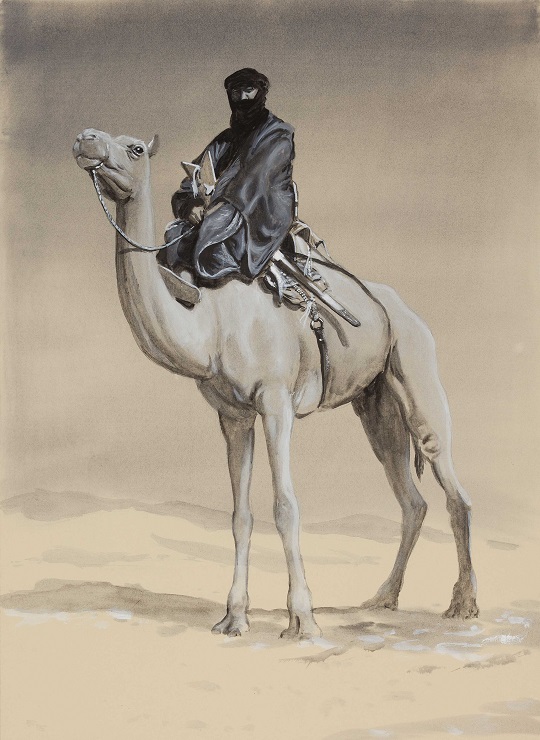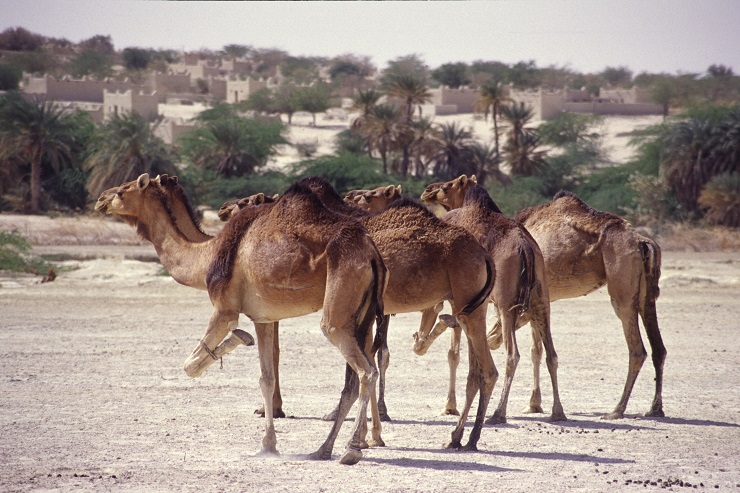 |
| The highest caste of the Touareg society was the warrior aristocracy. It was these blue fighters on camels who were to become the iconic image of desert nomads. Illustration by Petr Modlitba. |
In regard to nomads it is very difficult to define any specific pattern of settlement behaviour. One such attempt is the exceptional ethnoarchaeological study by Susan Smith that is dedicated to the Touareg (Kel Tamasheq) of the Sahel region. This nomadic population is interesting not only based on their nomadic lifestyle, but also their rigid social hierarchy, which is also reflected in the manner of structure of their camps. Long-term observation has enabled the creation of a model characteristic of their settlement.
Each of the Touareg clans consisted of several family groups led by their chieftain. More clans constituted a political confederation called a kel that was headed by its paramount chieftain, the amenokal. Migrating Touaregs’ camps were short-term and their location depended on the accessibility of a water source. The tent camps had an extraordinary variance of sizes, with between 10 and more than 100 inhabitants.
The society was traditionally divided into several mutually separated hereditary castes. Small numbers of the original noble warrior aristocracy that historically had focused on marauding raids on foreign herds and on the organisation of a long-distance caravan trade held the highest position. The second highest caste - warriors and herdsmen –was composed of freed vassals of aristocracy. Amongst the inferior groups were the client castes – craftsmen and repairmen of all types, also those dealing with the arts (i.e. music, poetry and storytelling). The lower class also included a caste of Islamic clerics that was constituted in the historical time, who nevertheless had a relatively large impact on the society. Another sub-class was the peasant caste, who cropped the land of their masters. Unfreed slaves constituted the lowest caste.
The specific spatial structure of the Touareg camp depended on how many of the social castes mentioned above were actually represented. The tents on the site were grouped in accordance with these impenetrable social categories; each of the castes had both their own defined and their prohibited places. The camps always had either some form of a sigmoid or of a “U” shape, with camels inside it and with other animals (cows, sheep, goats) outside. The longer axis of the camp always had a north to south orientation. According to Susan Smith a similar hierarchical campground would not leave an archaeological trail that would be too prominent - perhaps just the accumulation of a different kind of refuse could indicate some specific social arrangement.
|
|
| Camels constitute an integral part of the life of desert nomads. Amongst the Touareg they were originally owned exclusively by the tribal aristocrats, but later, however, the vassals also became their owners. Photo by Viktor Černý, Chad 2003. |
|
|
| Plan of the Tuareg Kel Tamasheq populace camp. Spatial distribution of dwellings of different social castes follows strict rules. The same applies to location of different domestic animals species. After Smith 1978. |
Want to learn more?
- Prasse, K.-G. 1995. The Tuaregs. The blue people. Copenhagen: Museum Tusculanum Press.
- Rasmussen, J. S. 1992. Ritual Specialists, Ambiguity and Power in Tuareg Society. Man. New Series 27 (1):105-128.
- Smith, E. S. 1978. The environmental adaptation of nomads in the west African Sahel: key to understanding prehistoric pastoralists. In The Nomadic Alternative: Modes and Models of Interaction in the African-Asian Deserts and Steppes, ed. W. Weissleder, 75-96. Hague: Mounton Publishers.
- Smith, A. B. 1992. Pastoralism in Africa: origins and development ecology. London: Hurst & Co.
 Archeologické 3D virtuální muzeum
Archeologické 3D virtuální muzeum

.jpg)

